Text and images Copyright
© 1998 - 2000 John A. Lind
Rule of Thirds
 The
"rule of thirds" is one of the most basic concepts of composition.
Draw imaginary lines through an image dividing it into thirds both horizontally
and vertically. This gives nine small rectangles the same ratio as
the original image and four points of intersection between the horizontal
and vertical lines. Each of these four intersections is a "point
of interest" where the eye of the viewer will naturally be drawn.
An object of interest placed one of the lines will be perceived as more
prominent in the image. An object of interest placed at an intersecting
"point of interest" will be perceived as much more prominent.
The
"rule of thirds" is one of the most basic concepts of composition.
Draw imaginary lines through an image dividing it into thirds both horizontally
and vertically. This gives nine small rectangles the same ratio as
the original image and four points of intersection between the horizontal
and vertical lines. Each of these four intersections is a "point
of interest" where the eye of the viewer will naturally be drawn.
An object of interest placed one of the lines will be perceived as more
prominent in the image. An object of interest placed at an intersecting
"point of interest" will be perceived as much more prominent.
Subject(s)
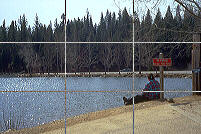 Placement
of one or more elements of the subject at (or very near) the intersecting
points adds power to them and makes them much more noticeable. Where
the subject(s) are placed is important. If there is a direction of
view or feeling of motion, the subject needs to be looking or moving into
the photograph. In the case of the fisherman photograph, his placement
at the lower right intersection captures not only him but a good portion
of the the view he has of the lake.
Placement
of one or more elements of the subject at (or very near) the intersecting
points adds power to them and makes them much more noticeable. Where
the subject(s) are placed is important. If there is a direction of
view or feeling of motion, the subject needs to be looking or moving into
the photograph. In the case of the fisherman photograph, his placement
at the lower right intersection captures not only him but a good portion
of the the view he has of the lake. 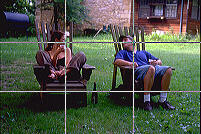 In the photograph with the two lovers looking at each other, their heads
are at the two upper intersecting points. The viewer is immediately
drawn to their faces and the fact they are "making eyes" at each other.
There is another compositional element working with the rule of thirds
in both of these photographs called "hidden leading lines" and are the
directions the subjects are looking. There is more about "leading
lines" and how they work in that section.
In the photograph with the two lovers looking at each other, their heads
are at the two upper intersecting points. The viewer is immediately
drawn to their faces and the fact they are "making eyes" at each other.
There is another compositional element working with the rule of thirds
in both of these photographs called "hidden leading lines" and are the
directions the subjects are looking. There is more about "leading
lines" and how they work in that section.
Horizon
 A
horizon should normally be placed along (or near) the upper or lower of
the two horizontal lines. Without some compelling reason for doing
so (see the exceptions), placement dead center splits the image unnaturally.
If severe enough it can seem like two separate images, an upper and lower.
Which line to use depends on the scene, what is to be depicted, and whether
the sky or the foreground is of greater interest in portraying the subject.
A
horizon should normally be placed along (or near) the upper or lower of
the two horizontal lines. Without some compelling reason for doing
so (see the exceptions), placement dead center splits the image unnaturally.
If severe enough it can seem like two separate images, an upper and lower.
Which line to use depends on the scene, what is to be depicted, and whether
the sky or the foreground is of greater interest in portraying the subject. 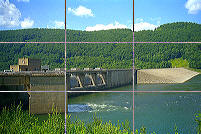 In the case of sunrises or sunsets, the horizon is usually placed along
the lower horizontal line. In other photographs, the location of
the subject and distant hills or mountains may dictate the location of
where the sky meets them. Uneven horizon can also affect placement
requiring thought about balancing how it appears in the image. Exact
placement is not essential, only approximate, and how well it fits with
the intended subject and how it is to be portrayed is an equally important
consideration.
In the case of sunrises or sunsets, the horizon is usually placed along
the lower horizontal line. In other photographs, the location of
the subject and distant hills or mountains may dictate the location of
where the sky meets them. Uneven horizon can also affect placement
requiring thought about balancing how it appears in the image. Exact
placement is not essential, only approximate, and how well it fits with
the intended subject and how it is to be portrayed is an equally important
consideration.
Lines
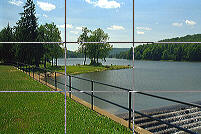 There
is more detail on "leading lines," perspective and vanishing points under
its own topic. Under this one, however, use of straight and curved
lines along (or near) "rule of thirds" lines, or to connect their intersecting
points tend to be aesthetically pleasing. Connecting or intersecting
where a "rule of thirds" line intersects the edge of the image also works.
Note also the line need not reach an intersection point, only head or "lead"
to it. It's not as powerful as actually crossing it, but the eye
and brain will normally extend perspective lines beyond where they end
in the image. There is no magic formula for how to align strong straight
and curved lines in an image with the "rule of thirds" lines and their
intersections (including at the image edges).
There
is more detail on "leading lines," perspective and vanishing points under
its own topic. Under this one, however, use of straight and curved
lines along (or near) "rule of thirds" lines, or to connect their intersecting
points tend to be aesthetically pleasing. Connecting or intersecting
where a "rule of thirds" line intersects the edge of the image also works.
Note also the line need not reach an intersection point, only head or "lead"
to it. It's not as powerful as actually crossing it, but the eye
and brain will normally extend perspective lines beyond where they end
in the image. There is no magic formula for how to align strong straight
and curved lines in an image with the "rule of thirds" lines and their
intersections (including at the image edges). 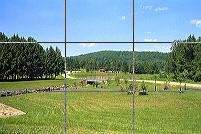 Very rare is a scene that has everything perfectly placed. When composing
an image, practice at identifying the strong lines that are present and
try different perspectives placing them at various points. Just as
exposure can be bracketed, how various elements and prominent lines in
the photographs align themselves with the "rule of thirds" lines and intersections
can be "bracketed" by taking photographs from multiple perspectives, sometimes
just slightly different. If necessary (and possible), move a little
closer or a little farther. With enough conscious practice, the hunt
for aligning elements and lines will start to become automatic, and when
it appears in the viewfinder the brain will lock in on it as simply looking
"right." Grid lines are not required in the viewfinder for exacting
placement; approximate works.
Very rare is a scene that has everything perfectly placed. When composing
an image, practice at identifying the strong lines that are present and
try different perspectives placing them at various points. Just as
exposure can be bracketed, how various elements and prominent lines in
the photographs align themselves with the "rule of thirds" lines and intersections
can be "bracketed" by taking photographs from multiple perspectives, sometimes
just slightly different. If necessary (and possible), move a little
closer or a little farther. With enough conscious practice, the hunt
for aligning elements and lines will start to become automatic, and when
it appears in the viewfinder the brain will lock in on it as simply looking
"right." Grid lines are not required in the viewfinder for exacting
placement; approximate works.
Exceptions
 What
would a rule be without exceptions? There are a couple of notable
ones to the "rule of thirds." The most often encountered are exceptionally
strong symmetry for architectural and strong reflection for scenic (and
sometimes windows, chrome finishes, etc.) which is another form of symmetry.
What
would a rule be without exceptions? There are a couple of notable
ones to the "rule of thirds." The most often encountered are exceptionally
strong symmetry for architectural and strong reflection for scenic (and
sometimes windows, chrome finishes, etc.) which is another form of symmetry. 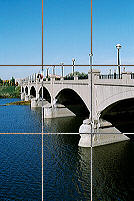 Very strong symmetry in an image will override nearly all other compositional
factors. In the several images provided as examples of exceptions,
there may be some modest use of "rule of thirds" lines and intersections.
Most commonly discarded is locating the horizon either high or low and
placing it dead center. The nature of the symmetric subject will
determine its placement in the image. In the case of the hood ornament
it felt more natural to have it leaping into the image versus leaping toward
the edge.
Very strong symmetry in an image will override nearly all other compositional
factors. In the several images provided as examples of exceptions,
there may be some modest use of "rule of thirds" lines and intersections.
Most commonly discarded is locating the horizon either high or low and
placing it dead center. The nature of the symmetric subject will
determine its placement in the image. In the case of the hood ornament
it felt more natural to have it leaping into the image versus leaping toward
the edge. 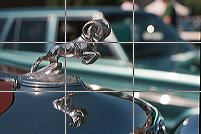 In the case of the pond, the strength of the water reflection and its general
shape allows a centered horizon to work with a few other subject elements
intersecting the image edge near a "rule of thirds" line. If in doubt,
hunt for a pleasing subject placement in the viewfinder and "bracket" the
perspective taking several photographs (if possible) trying different horizon
locations and positions of very strong lines. In general though,
it is best to let a strong symmetry express itself with the balance of
the symmetrical parts matching the balance of how they are placed in the
image.
In the case of the pond, the strength of the water reflection and its general
shape allows a centered horizon to work with a few other subject elements
intersecting the image edge near a "rule of thirds" line. If in doubt,
hunt for a pleasing subject placement in the viewfinder and "bracket" the
perspective taking several photographs (if possible) trying different horizon
locations and positions of very strong lines. In general though,
it is best to let a strong symmetry express itself with the balance of
the symmetrical parts matching the balance of how they are placed in the
image.
 The
"rule of thirds" is one of the most basic concepts of composition.
Draw imaginary lines through an image dividing it into thirds both horizontally
and vertically. This gives nine small rectangles the same ratio as
the original image and four points of intersection between the horizontal
and vertical lines. Each of these four intersections is a "point
of interest" where the eye of the viewer will naturally be drawn.
An object of interest placed one of the lines will be perceived as more
prominent in the image. An object of interest placed at an intersecting
"point of interest" will be perceived as much more prominent.
The
"rule of thirds" is one of the most basic concepts of composition.
Draw imaginary lines through an image dividing it into thirds both horizontally
and vertically. This gives nine small rectangles the same ratio as
the original image and four points of intersection between the horizontal
and vertical lines. Each of these four intersections is a "point
of interest" where the eye of the viewer will naturally be drawn.
An object of interest placed one of the lines will be perceived as more
prominent in the image. An object of interest placed at an intersecting
"point of interest" will be perceived as much more prominent.
 Placement
of one or more elements of the subject at (or very near) the intersecting
points adds power to them and makes them much more noticeable. Where
the subject(s) are placed is important. If there is a direction of
view or feeling of motion, the subject needs to be looking or moving into
the photograph. In the case of the fisherman photograph, his placement
at the lower right intersection captures not only him but a good portion
of the the view he has of the lake.
Placement
of one or more elements of the subject at (or very near) the intersecting
points adds power to them and makes them much more noticeable. Where
the subject(s) are placed is important. If there is a direction of
view or feeling of motion, the subject needs to be looking or moving into
the photograph. In the case of the fisherman photograph, his placement
at the lower right intersection captures not only him but a good portion
of the the view he has of the lake.  In the photograph with the two lovers looking at each other, their heads
are at the two upper intersecting points. The viewer is immediately
drawn to their faces and the fact they are "making eyes" at each other.
There is another compositional element working with the rule of thirds
in both of these photographs called "hidden leading lines" and are the
directions the subjects are looking. There is more about "leading
lines" and how they work in that section.
In the photograph with the two lovers looking at each other, their heads
are at the two upper intersecting points. The viewer is immediately
drawn to their faces and the fact they are "making eyes" at each other.
There is another compositional element working with the rule of thirds
in both of these photographs called "hidden leading lines" and are the
directions the subjects are looking. There is more about "leading
lines" and how they work in that section.
 A
horizon should normally be placed along (or near) the upper or lower of
the two horizontal lines. Without some compelling reason for doing
so (see the exceptions), placement dead center splits the image unnaturally.
If severe enough it can seem like two separate images, an upper and lower.
Which line to use depends on the scene, what is to be depicted, and whether
the sky or the foreground is of greater interest in portraying the subject.
A
horizon should normally be placed along (or near) the upper or lower of
the two horizontal lines. Without some compelling reason for doing
so (see the exceptions), placement dead center splits the image unnaturally.
If severe enough it can seem like two separate images, an upper and lower.
Which line to use depends on the scene, what is to be depicted, and whether
the sky or the foreground is of greater interest in portraying the subject.  In the case of sunrises or sunsets, the horizon is usually placed along
the lower horizontal line. In other photographs, the location of
the subject and distant hills or mountains may dictate the location of
where the sky meets them. Uneven horizon can also affect placement
requiring thought about balancing how it appears in the image. Exact
placement is not essential, only approximate, and how well it fits with
the intended subject and how it is to be portrayed is an equally important
consideration.
In the case of sunrises or sunsets, the horizon is usually placed along
the lower horizontal line. In other photographs, the location of
the subject and distant hills or mountains may dictate the location of
where the sky meets them. Uneven horizon can also affect placement
requiring thought about balancing how it appears in the image. Exact
placement is not essential, only approximate, and how well it fits with
the intended subject and how it is to be portrayed is an equally important
consideration.
 There
is more detail on "leading lines," perspective and vanishing points under
its own topic. Under this one, however, use of straight and curved
lines along (or near) "rule of thirds" lines, or to connect their intersecting
points tend to be aesthetically pleasing. Connecting or intersecting
where a "rule of thirds" line intersects the edge of the image also works.
Note also the line need not reach an intersection point, only head or "lead"
to it. It's not as powerful as actually crossing it, but the eye
and brain will normally extend perspective lines beyond where they end
in the image. There is no magic formula for how to align strong straight
and curved lines in an image with the "rule of thirds" lines and their
intersections (including at the image edges).
There
is more detail on "leading lines," perspective and vanishing points under
its own topic. Under this one, however, use of straight and curved
lines along (or near) "rule of thirds" lines, or to connect their intersecting
points tend to be aesthetically pleasing. Connecting or intersecting
where a "rule of thirds" line intersects the edge of the image also works.
Note also the line need not reach an intersection point, only head or "lead"
to it. It's not as powerful as actually crossing it, but the eye
and brain will normally extend perspective lines beyond where they end
in the image. There is no magic formula for how to align strong straight
and curved lines in an image with the "rule of thirds" lines and their
intersections (including at the image edges).  Very rare is a scene that has everything perfectly placed. When composing
an image, practice at identifying the strong lines that are present and
try different perspectives placing them at various points. Just as
exposure can be bracketed, how various elements and prominent lines in
the photographs align themselves with the "rule of thirds" lines and intersections
can be "bracketed" by taking photographs from multiple perspectives, sometimes
just slightly different. If necessary (and possible), move a little
closer or a little farther. With enough conscious practice, the hunt
for aligning elements and lines will start to become automatic, and when
it appears in the viewfinder the brain will lock in on it as simply looking
"right." Grid lines are not required in the viewfinder for exacting
placement; approximate works.
Very rare is a scene that has everything perfectly placed. When composing
an image, practice at identifying the strong lines that are present and
try different perspectives placing them at various points. Just as
exposure can be bracketed, how various elements and prominent lines in
the photographs align themselves with the "rule of thirds" lines and intersections
can be "bracketed" by taking photographs from multiple perspectives, sometimes
just slightly different. If necessary (and possible), move a little
closer or a little farther. With enough conscious practice, the hunt
for aligning elements and lines will start to become automatic, and when
it appears in the viewfinder the brain will lock in on it as simply looking
"right." Grid lines are not required in the viewfinder for exacting
placement; approximate works.
 What
would a rule be without exceptions? There are a couple of notable
ones to the "rule of thirds." The most often encountered are exceptionally
strong symmetry for architectural and strong reflection for scenic (and
sometimes windows, chrome finishes, etc.) which is another form of symmetry.
What
would a rule be without exceptions? There are a couple of notable
ones to the "rule of thirds." The most often encountered are exceptionally
strong symmetry for architectural and strong reflection for scenic (and
sometimes windows, chrome finishes, etc.) which is another form of symmetry.  Very strong symmetry in an image will override nearly all other compositional
factors. In the several images provided as examples of exceptions,
there may be some modest use of "rule of thirds" lines and intersections.
Most commonly discarded is locating the horizon either high or low and
placing it dead center. The nature of the symmetric subject will
determine its placement in the image. In the case of the hood ornament
it felt more natural to have it leaping into the image versus leaping toward
the edge.
Very strong symmetry in an image will override nearly all other compositional
factors. In the several images provided as examples of exceptions,
there may be some modest use of "rule of thirds" lines and intersections.
Most commonly discarded is locating the horizon either high or low and
placing it dead center. The nature of the symmetric subject will
determine its placement in the image. In the case of the hood ornament
it felt more natural to have it leaping into the image versus leaping toward
the edge.  In the case of the pond, the strength of the water reflection and its general
shape allows a centered horizon to work with a few other subject elements
intersecting the image edge near a "rule of thirds" line. If in doubt,
hunt for a pleasing subject placement in the viewfinder and "bracket" the
perspective taking several photographs (if possible) trying different horizon
locations and positions of very strong lines. In general though,
it is best to let a strong symmetry express itself with the balance of
the symmetrical parts matching the balance of how they are placed in the
image.
In the case of the pond, the strength of the water reflection and its general
shape allows a centered horizon to work with a few other subject elements
intersecting the image edge near a "rule of thirds" line. If in doubt,
hunt for a pleasing subject placement in the viewfinder and "bracket" the
perspective taking several photographs (if possible) trying different horizon
locations and positions of very strong lines. In general though,
it is best to let a strong symmetry express itself with the balance of
the symmetrical parts matching the balance of how they are placed in the
image.